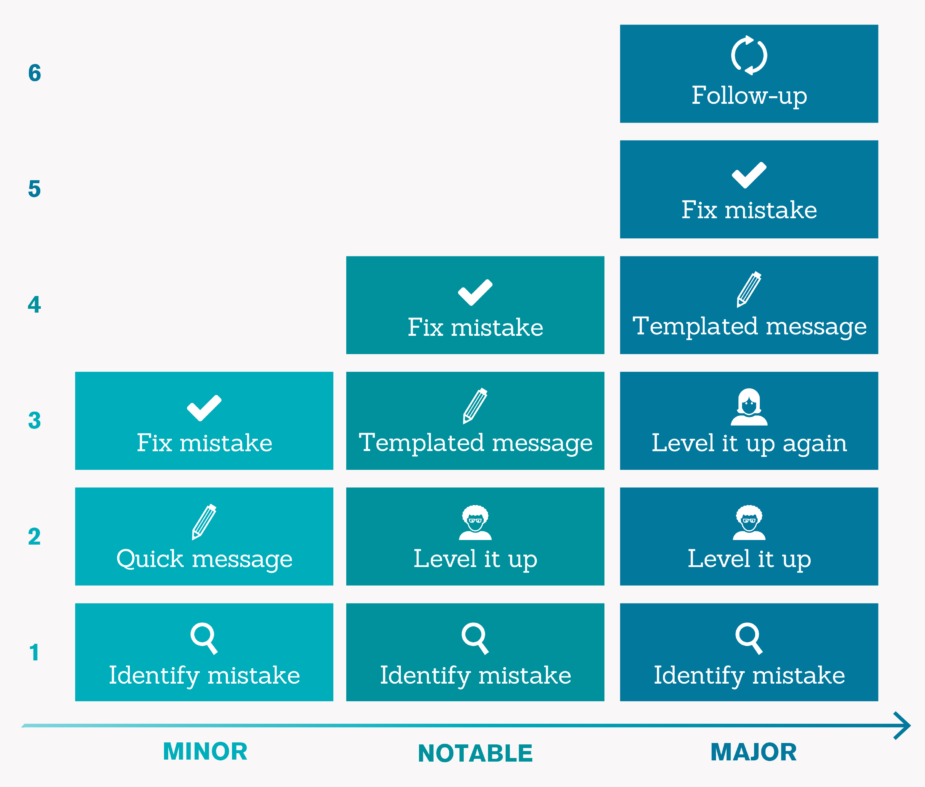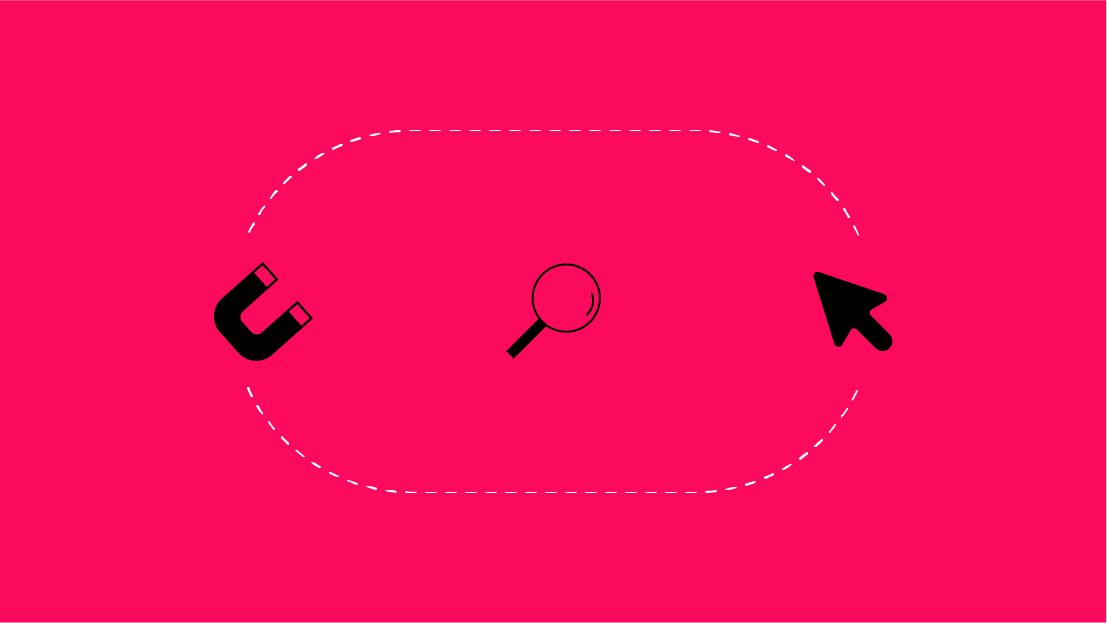What to Do When Something Goes Wrong
We’re all human, and as humans, we are imperfect. That means that we all will, at some point, make mistakes on clients we work on.

We can take steps to ensure these mistakes don’t happen, but ultimately, each mistake should teach us a lesson, and show us a way to improve in the future. As long as mistakes aren’t repeated, they can help us (and others) improve in the future.
Whether these are major strategic mistakes, or a simple spelling error, they are important in how you present yourself and your company.
Continual mistakes erode trust from a client, and we want to avoid that. Worse than that, not owning a mistake right away really erodes trust, and it’s much better for us to call out a mistake then have a client call us out on it.
Most companies actively avoid calling out their mistakes, so owning mistakes when they happen can set you apart in your transparency.
Preventing Mistakes
It is ideal for mistakes not to happen, and anyone should have safeguards in place (review processes, for one example) to ensure they ideally don’t.

A few key things to remember that will help to prevent mistakes:
- Always have work reviewed by an objective set of eyes. This process ensures that everyone gets a second (or third) pair of eyes on their work, and mistakes can then be (hopefully) avoided. This goes for everyone at all levels, whether you are a beginner or an expert in your field.
- Ask for help! An easy way to have mistakes on your work is not having a clear picture of what you need to accomplish or having the wrong direction heading into a task. If you collaborate with others on your tasks, you should give clear direction, and ensure you have clear direction going into the task.
- Share learnings from your mistakes. We’ve all made mistakes, so regardless of position or division, sharing it with others on the team (or the company as a whole), can help us all. There’s a good chance someone else has faced a similar position to you in the past or is likely to face a similar situation in the future.
Overall, we are all here to help each other at whatever company you work at, so leverage that help to improve yourself and others in the future.
Levels of Mistakes
You’ve sent something out and realized there is a mistake. Eek! What to do now? Not all mistakes are created equal. So, when you make a mistake, categorize it based on how severe the mistake is.
To illustrate this, let’s give some examples for someone working on a major quarterly analysis (I’m doing this based on an analytics practitioner, but you can scale for any position/industry).
Minor Mistakes
- Definition: Largely inconsequential -- should still be fixed.
- Examples: Misspelling a word, leaving a word out, forgetting to change a copyright date, misnaming a file, etc.
- What to Do: Immediately call out the mistake (quick one sentence message) and fix. Send out an updated version of the deliverable with the mistake fixed.
Notable Mistakes
- Definition: Slightly impacts data interpretation, collection, etc. -- can be quickly rectified.
- Examples: Mixing up a section in an analysis, having an incorrect number, having a misleading data visualization, etc.
- What to Do: Level up to your superiors and use the Mistake Template Message.
Major Mistakes
- Definition: Severely/drastically impacts data interpretation, collection, etc. -- will have long-lasting effects.
- Examples: Analyzing the wrong data overall, using the wrong date range to analyze data, making a recommendation based on incorrect data, etc.
- What to Do: Level up to your superiors and use the Mistake Template Message.
Ultimately, this leads to the following flows:

- Minor Mistake: Mistake Identified > Quick Message > Fix Mistake
- Notable Mistake: Mistake Identified > Level to Immediate Superior > Use Mistake Template Message > Fix Mistake
- Major Mistake: Mistake Identified > Level to Immediate Superior > Your Immediate Superior Levels Up to their Immediate Superior, etc. (if necessary) > Use Mistake Template Message > Fix Mistake > Follow Up Regularly
Owning Mistakes
Ultimately, the character is shown of an individual (and the company) by how they deal when a mistake comes up. Most companies actively try to avoid blame from a mistake, place blame elsewhere, etc. Your company can be set apart by owning these mistakes and taking action immediately.
Whether this is a mistake over email, other written communication platforms, in-person, on a call, etc. this framework should work the same. If this occurs in-person or on a call, it is even more important to call it out right away in the moment if possible. This is also critical to avoid putting yourselves (and others) in these situations, as there is less time flexibility to react in most cases.
Templated Message
You’ve made a mistake, what now? Usually, most people feel terrible when a mistake is made, and if it is a notable or major mistake, natural emotions of worry, concern, or even panic can overtake. It is important to separate yourself from the situation, and be clear, objective and swift in your action.
This is a situation that benefits from clear direction and easy to understand next steps. Given that, here’s is my template to communicate to the client:
| Hi [Client Name], We’re reaching out to note a mistake that we’ve found in [insert previous deliverable/email/etc. here]. Here is what occurred, and the actions we are taking to fix it: What Happened: [insert a quick explanation of exactly what occurred -- make it simple and easy to understand (2-4 sentences maximum)] Impact: [insert a clearly articulated explanation of the impact (if any) this mistake has had / will have. This is especially important in data collection situations (2-3 sentences maximum)] What We’ve Done: [insert a detailed outline of exactly what you’ve done / plan to do to fix the mistake. Is it permanent, or can it be fixed? How/when? (1-2 sentences maximum)] Future Next Steps: [insert a quick explanation of what you’re doing in the long-term to prevent this mistake in the future. Clear and exact steps to give the client confidence is key (1-2 sentences maximum)] Please let us know if you have any questions. Optional: [insert an apology. Depending on the client, stage of the project, etc. it can be worth formally apologizing and showing responsibility for the situation that you created -- especially if it was a major mistake. However, most mistakes are best owned through simple acknowledgement (as detailed above) so make sure to consult your superiors first.] - [Your Team] |
Diffusing a Volatile Situation
If at any point the mistake escalates to the point where the client seems actively agitated, annoyed, or angry, you’ll want to loop in your immediate superior to the situation. It is their job to help guide you along a path to de-escalate the situation.
Usually in this situation, the client simply wants their grievances to be heard. If this happens on a call or in-person, work to de-escalate the situation by clearly owning responsibility (if valid), outline next steps, and hear the client out.
Be empathetic and understanding of the situation from the other person's point of view.
Next Steps
For some mistakes, it is as simple as fixing and then proceeding as normal.
However, for major mistakes, if this is an item dealing with data collection or data quality, it could be worth following up at a normal cadence to give an update on where things stand (next day, 1 week out, etc.). This should be repeated until the mistake is fully resolved. Again this all depends on severity, the client, etc.
If you’d want to work with an agency that has guidelines in place to prevent mistakes - but owns that they can still happen and will quickly resolve them - Seer might be the right agency for you.


